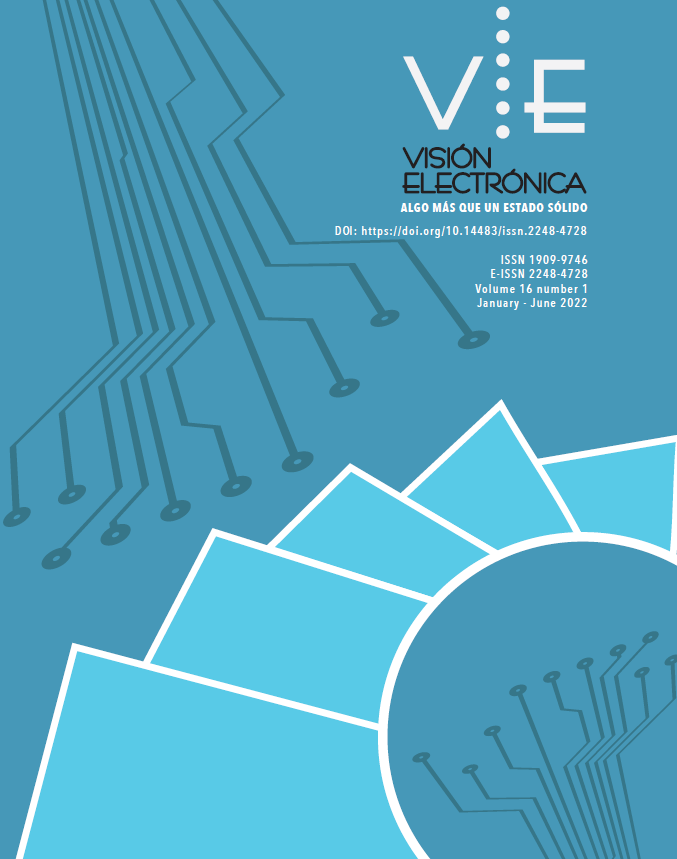Publicado:
2022-06-30Número:
Vol. 16 Núm. 1 (2022)Sección:
Visión de CasoTecnologías automatizadas implementadas en la FMS HAS200
Automated technologies implemented in the FMS HAS200
Palabras clave:
Gripper, HAS200, Robotic arm, UGV, Virtual reality environment (en).Palabras clave:
Gripper, HAS200, Brazo robótico, UGV, Ambientes de realidad virtual (es).Descargas
Resumen (es)
En este artículo se presenta la automatización implementada a través de una serie de proyectos orientados hacia el continuo mejoramiento y desarrollo de los sistemas didácticos presentes en celdas de manufactura flexibles HAS200 de la Facultad Tecnológica de la Universidad Distrital Francisco José de Caldas. Por medio de dichos proyectos se ha logrado implementar una serie de mejoras automatizadas como por ejemplo: i) un entorno virtual de la celda de manufactura flexible, modelado geométricamente para la simulación remota de los procesos didácticos; ii) una novedosa estación automatizada para el reciclaje de pellets que se integra con las demás estaciones para clasificar la materia prima en tres colores separados; iii) una nueva interfaz de usuario-máquina para un brazo manipulador Melfa Mitsubishi RV-M1, que permite integrar la estación de reciclaje con el resto de la celda de manufactura flexible; iv) un diseño de gripper automatizado, para la manipulación y posterior apertura de recipientes dentro de la celda; v) un sistema de visión artificial implementado al transporte autónomo alterno de producto entre estaciones mediante vehículos terrestres no tripulados; vi) un curso virtual para el manejo y operación de la celda de manufactura flexible. La automatización propuesta en la HAS200 puede ser extrapolable hacia entornos productivos reales bajo los mismos conceptos de automatización, lo cual hace que cada resultado obtenido sea doblemente beneficioso.
Resumen (en)
This paper presents the automation implemented through a series of projects oriented towards the continuous improvement and development of the didactic systems present in HAS200 flexible manufacturing cells of the Facultad Tecnológica of the Universidad Distrital Francisco José de Caldas. Through these projects, it has been possible to implement a series of automated improvements such as (i) a virtual environment of the flexible manufacturing cell, geometrically modeled for remote simulation of the didactic processes; (ii) a new automated station for recycling pellets that is integrated with the other stations to classify the raw material in three separate colors; (iii) a new user-machine interface for a Melfa Mitsubishi RV-M1 manipulator arm, which allows the recycling station to be integrated with the rest of the flexible manufacturing cell; iv) an automated gripper design for handling and subsequent opening of containers within the cell; v) an artificial vision system implemented to alternate autonomous transport of product between stations using unmanned ground vehicles; vi) a virtual course for the management and operation of the flexible manufacturing cell. The automation strategies proposed in the HAS200 can be extrapolated to real production environments under the same automation concepts, which makes each result obtained doubly beneficial.
Referencias
N. Reddy, N. Maheshwari, D. K. Sahu, G. K. Ananthasuresh, "Miniature Compliant Grippers with Vision-Based Force Sensing", IEEE Transactions on Robotics, vol. 26, no. 5, pp. 867-877, 2010. https://doi.org/10.1109/TRO.2010.2056210
A. Barraza, J. Rúa, Y. Sosa, E. Yime, J. Roldan, “Dynamic modeling of the Mitsubishi Movemaster RV-M1 serial manipulator using SolidWorks”, Revista de la facultad de Ingenierias Físicas Físicas Mecánicas, pp. 49-62, 2015.
Y. Benbelkacem, R. Mohd-Mokhtar, “Explicit kinematic model of the Mitsubishi RV-M1 robot arm”, International Conference on Control, Automation and Information Sciences (ICCAIS), pp. 404-409, 2012. https://doi.org/10.1109/ICCAIS.2012.6466627
B. Benito, “Integration of a UAV (unmanned aerial vehicle) in the ARGOS robotic platform”, Universidad Autónoma de Madrid, 2015.
DARMOUL Saber, “Reality for Manufacturing: A Robotic Cell Case Study”, Department of Industrial Engineering, King Saud University, Saudi Arabia, 2015.
H. Xin, H. Lu, W. Luo, H. Shao, “Research on Assembly Modeling Process Based on Virtual Manufacturing Interactive Application Technology”, 2nd International Conference on Robotics and Automation Engineering (ICRAE) 2017. https://doi.org/10.1109/ICRAE.2017.8291411
A. Barraza, J. Rúa, J. Sosa, E. Yime, J. Roldan, “Dynamic modeling of the Mitsubishi Movemaster RV-M1 serial manipulator using SolidWorks”, Revista de la facultad de Ingenierias Físicas Físicas Mecánicas, pp. 49-62, 2015.
L. L. Hurtado-Cortés, J. A. Forero-Casallas, V. E. Ruiz-Rosas, “Artificial vision applied to manufacturing process”, Vis. Electron., vol. 15, no. 1, pp. 113–122, 2021. https://doi.org/10.14483/22484728.17432
C. Marcu, C., Lazea, S. Herle, R. Robotin, L. Tamas, “3D graphical simulation of an articulated serial manipulator based on kinematic models”, 19th International Workshop on Robotics in Alpe-Adria-Danube Region (RAAD 2010), 2017. https://doi.org/10.1109/RAAD.2010.5524593
C. A. González González, F. Arévalo Tapias, J. Hernández Gutiérrez, “Análisis de seguridad en redes LPWAN para dispositivos IoT”, Rev. Vínculos, vol. 16, no. 2, pp. 252–261, 2019. https://doi.org/10.14483/2322939X.15712
H. A. Hernández Martínez, L. A. Luengas Contreras, “Control of diversity in genetic algorithms using multimodal strategies”, Vis. Electron., vol. 13, no. 1, pp. 144–151, 2019. https://doi.org/10.14483/22484728.14402
Cómo citar
APA
ACM
ACS
ABNT
Chicago
Harvard
IEEE
MLA
Turabian
Vancouver
Descargar cita
Visitas
Descargas
Licencia
Derechos de autor 2022 Visión electrónica

Esta obra está bajo una licencia internacional Creative Commons Atribución-NoComercial 4.0.
.png)
atribución- no comercial 4.0 International






.jpg)





